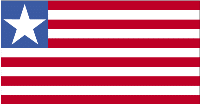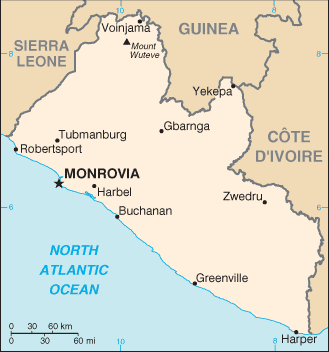Sep 3 2012
Liberia is located in Western Africa and borders the North Atlantic Ocean between Sierra Leone and Cote d'Ivoire. The country has a total area of 111,369 km2 and a population of 3,887,886 as per 2010 estimates. It has tropical, hot and humid climatic conditions.
 |
The national flag of Liberia.
Image Credits: CIA Factbook. |
The country is awash with natural resources like gold, diamond and iron ore. Liberia is a low-income country dependant on foreign investments for revenue. All the major mines in the country were shut down during the civil war that ended in 2003 and hence the mineral industry's contribution to the country's economy was reduced drastically.
However, in 2010, the country made significant progress, especially in the mining sector, which contributed nearly 0.9% to the country's GDP growth. The GDP was $1.792 billion in 2011, compared to $1.684 billion in 2010 and $1.604 billion in 2009.
Overview of Resources
The major mineral commodities produced in Liberia include gold, diamond and cement. Base metals such as tin, nickel, manganese, lead and cobalt and industrial minerals such as sulfur, silica sand, rutile, phosphate rock, kyanite, ilmenite, granite and dolorite are the some of the country’s undeveloped mineral resources.
Metals
In 2010, the New Liberty Gold (NLG) deposit located near Monrovia and owned by African Aura was estimated to contain 7 million metric tons (Mt) of inferred resources of gold ore at an average grade of 3.4 g/Mt of gold. As per the feasibility study reports, the NLG mine has the capacity to produce 3,100 kg per year of gold.
The inferred mineral resources of the Putu iron ore project were 1.08 billion Mt of iron ore in 2010. Iron ore deposits in Nimba County are expected to produce 1 million Mt of iron ore per year. In 2010, the Liberian government estimated the iron ore reserves at Mano River to be 80 Mt having about 51% iron and that of Bomi Hills deposits to be 50 Mt having nearly 68% iron.

The map of Liberia. Image Credits: CIA Factbook
Industrial Minerals
Scancem International ANS of Norway, a subsidiary of HeidelbergCement AG of Germany, is the only producer of cement in Liberia. In 2010, the company operated a grinding plant in Monrovia that produced portland cement.
Nearly 12 new diamond deposits were identified at Sehnkewen Cesto by Fundy Minerals Ltd. of Canada in June 2009. Furthermore, about five diamond drilling holes were completed at the Gondoja Hills area in 2011. Owing to shortage of mechanized equipment and other hand tools, the country’s diamond production decreased by 12% to 25,000 carats in 2010, compared to 28,368 carats in 2009.
Fossil Fuels
In September 2010, Chevron Corp. of the United States received approval from the government to acquire a 70% share and operatorship of three deepwater concessions in Oranto Petroleum Ltd. of Nigeria.
Investment
Liberia has the credit of having the world's highest ratio of direct foreign investment to GDP. Thanks to financial assistance from the donor countries and foreign investments, the country is likely to see an increase in revenues and rebuild its infrastructure.
The government has established a new mineral policy, which focuses on the development of the mining sector and the establishment of the Extractive Industries Transparency Initiative. The country seemingly has a transparent investment climate, which will likely attract more foreign investment in the mineral sector. Moreover, many multinational corporations are getting involved in the country’s petroleum exploration activities, which indicate that the foreign direct investment in the country is expected to continue.
According to recent reports, Liberians are demanding for a new Petroleum Policy in order to allocate a percentage of the oil revenue for the areas where oil reserves has been discovered. They are also recommending training opportunities for the people to run the oil sector. Hence the government is planning to establish new petroleum law in accordance with the inputs from the Liberians.
With all such promising policies and other comprehensive plans by the government to redevelop the country’s iron ore, cement, gold and diamond resources, the mining sector of the country is likely to become one of the major sources of employment and foreign exchange in the near future.
Disclaimer: The Author of this article does not imply any investment recommendation and some content is speculative in nature. The Author is not affiliated in any way with any companies mentioned and all statistical information is publically available.
Sources and Further Reading